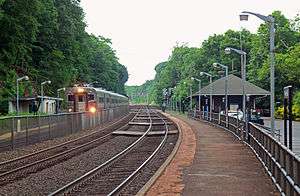Ho-Ho-Kus station
Ho-Ho-Kus is a NJ Transit station served by the Bergen County Line and Main Line. The station is located in Ho-Ho-Kus, New Jersey, at Brookside Avenue and 1st Street, across the bridge on Warren Avenue from Franklin Turnpike.
Ho-Ho-Kus | ||||||||||||||
|---|---|---|---|---|---|---|---|---|---|---|---|---|---|---|
 A train arriving in Ho-Ho-Kus on its way towards Hoboken Terminal in 2011. The station depot is visible on the right side. | ||||||||||||||
| Coordinates | 40.9974°N 74.1133°W | |||||||||||||
| Owned by | NJ Transit | |||||||||||||
| Platforms | 2 side platforms | |||||||||||||
| Tracks | 3 | |||||||||||||
| Other information | ||||||||||||||
| Station code | 2317 (Erie Railroad)[1] | |||||||||||||
| Fare zone | 10 | |||||||||||||
| History | ||||||||||||||
| Opened | October 19, 1848[2][3] | |||||||||||||
| Rebuilt | 1860, 1886, 1908[4][5] | |||||||||||||
| Traffic | ||||||||||||||
| Passengers (2012) | 440 (average weekday)[6] | |||||||||||||
| Services | ||||||||||||||
| ||||||||||||||
| ||||||||||||||
History
The station's current westbound structure was constructed in 1908 with river stones and a tile roof. This replaced facilities built in 1886 that burned. The first station, built in 1860, had also burned down several years after construction.[5] The eastbound side was an irregularly shaped waiting shed built in 1909.[7]
Station layout
This station has three tracks, the outer two of which are served by low-level side platforms.
| P Platform level |
Side platform, doors will open on the right | |
| Track 3 | ← Main Line and Bergen County Line toward Waldwick or Suffern (Waldwick) ← Port Jervis Line limited service toward Port Jervis (Waldwick) | |
| Track 2 | ← Main Line and Bergen County Line toward Waldwick or Suffern (Waldwick) ← Port Jervis Line limited service toward Port Jervis (Waldwick) | |
| Track 1 | Port Jervis Line express track towards Port Jervis (Ridgewood) → Main Line and Bergen County Line toward Hoboken (Ridgewood) → | |
| Side platform, doors will open on the right | ||
| G | Street level | Station building, ticket machines, parking |
gollark: Why not just make it so that the server can be rebooted by anyone ever via an HTTP API?
gollark: Time to deploy the secret GTech™ block scanner network.
gollark: I see. I'll check the entire south area.
gollark: Where is it?
gollark: Cool.
References
- "List of Station Names and Numbers". Jersey City, New Jersey: Erie Railroad. May 1, 1916. Retrieved November 23, 2010.
- "Common Council". The New York Herald. October 17, 1848. p. 1. Retrieved June 18, 2020 – via Newspapers.com.

- "Ramapo and Paterson and Paterson and Hudson River Railroads". The Evening Post. New York, New York. December 7, 1848. p. 4. Retrieved June 18, 2020 – via Newspapers.com.

- Ridgewood, Bergen County, New Jersey, Past and Present. Ridgewood, New Jersey: Citizens Semi-Centennial Association. December 1916. p. 112. Retrieved February 8, 2018.
- "11.0 - Historic Preservation Element". Ho-Ho-Kus Borough Master Plan. Borough of Ho-Ho-Kus, New Jersey. Archived from the original on March 25, 2012. Retrieved November 9, 2011.
- "QUARTERLY RIDERSHIP TRENDS ANALYSIS" (PDF). New Jersey Transit. Archived from the original (PDF) on December 27, 2012. Retrieved January 4, 2013.
- Yanosey, Robert J. (2006). Erie Railroad Facilities (In Color). 1. Scotch Plains, New Jersey: Morning Sun Books Inc. p. 49. ISBN 1-58248-183-0.
This article is issued from Wikipedia. The text is licensed under Creative Commons - Attribution - Sharealike. Additional terms may apply for the media files.